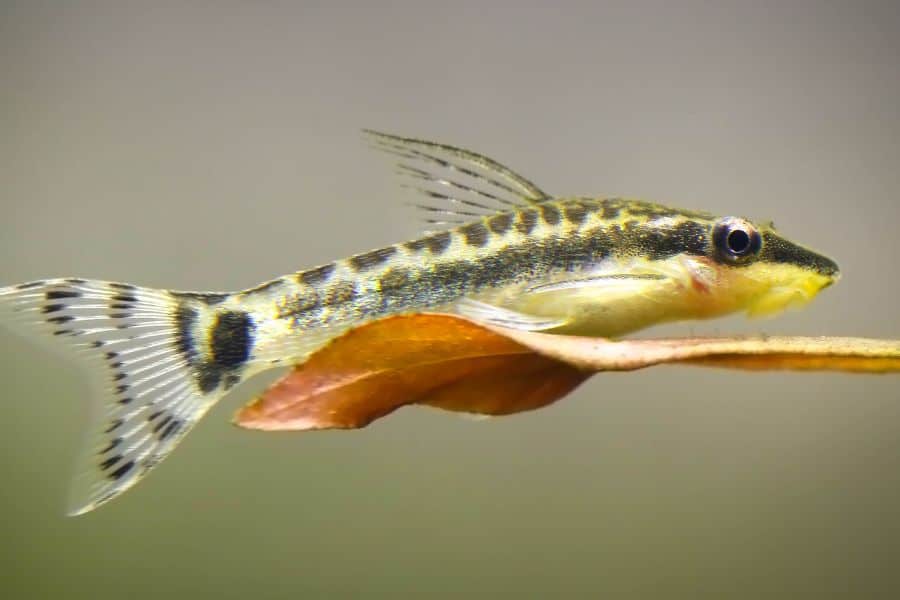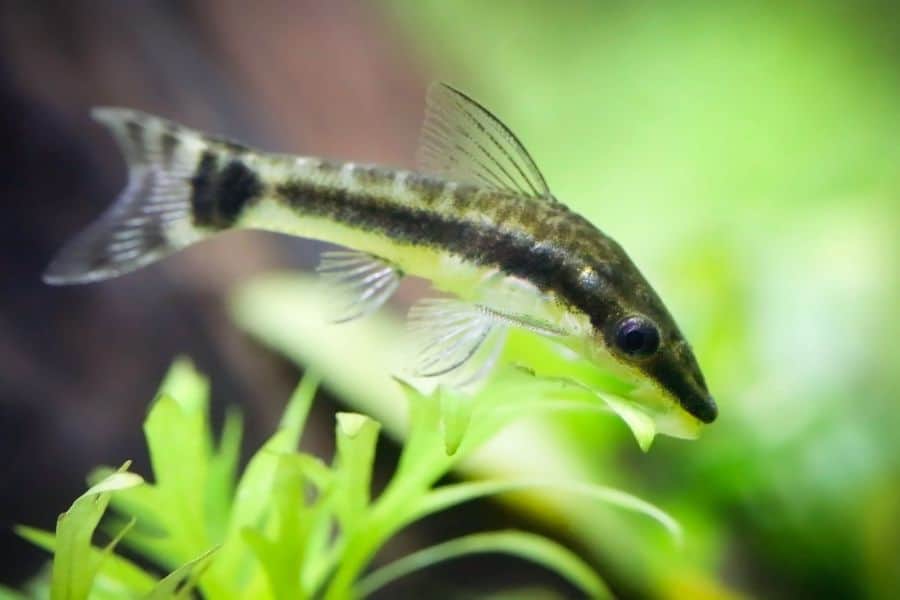There are over 2,900 different types of catfish, and the Otocinclus catfish stands out as one of the best and most highly popular aquarium catfish.
This skittish fish is beloved by many experts and beginners alike because it’s very cute, extremely easy to care for, and is such a peaceful addition to any aquarium.
Also known as the dwarf-sucking catfish, the Otocinclus catfish are also popular because they are excellent algae eaters that will improve your water quality in no time.
The species also has shy behaviors as well as extremely fast swimming speeds. Its small size makes it a great choice for those looking to get smaller tanks and want a low-maintenance fish.
Let’s just say if you are looking for a small fish that is easy to care for, then the Otocinclus Catfish is a good place to start.
They are basically the perfect fish.
This complete guide will take you through the origins, distribution, and habitat of the Otos. You will also learn of the Oto’s behaviors, temperament, diet, breeding cycle, and how to properly care for it to ensure it has a long lifespan.
Otocinclus Catfish (Dwarf Suckers) Overview
| Names | Otocinclus Catfish
Commonly referred to as Oto, Oto cat, Midget sucker fish, dwarf suckers, dwarf sucking catfish. |
| Scientific Name | Otocinclus genus –
Types of Catfish under the genus: |
| Origins & Distribution | Natively from South America and distributed across the region from Colombia to Northern Venezuela to Argentina, and East of Andes. |
| Minimum Tank Size | 20-gallon tank for about 10 Otos |
| Water Hardness Conditions | 4 – 20 dGH |
| Ideal Tank Mates | Similar, peaceful, equal-sized fish. |
| Average Size | Up to 2 inches |
| Lifespan | Up to 5 years |
| Substrate | Smooth like soft sand |
| Optimal pH levels | 6.5 – 8.0 |
| Optimal Temperature | 70 – 80 degrees Fahrenheit |
| Diet | Herbivores, algae eaters |
What is an Otocinclus Catfish
The Otocinclus Catfish is a whole genus of South American native catfish consisting of 22 categorized species. Distinct characteristics of the Otocinclus include the underslung suckermouth, which gives them the name ‘dwarf suckers.’
As part of the Loricariidae family, the Otocinclus, or Otos, have armored plating throughout their bodies arranged in distinct rows. All of them are small, spanning no more than 2 inches in length, and they all have the capability to breathe in atmospheric air.
They are known worldly as good algae eaters who would do a great job as a cleaning crew for your algae-infested tank. The Otos are so good at cleaning algae that you can expect them to remove unwanted algae in less than 9 days completely.
Please keep in mind that Otos in captivity may prefer commercial algae wafers and vegetables like lettuce and spinach. Needless to say, they love an herbivorous diet rich in plant matter and bacteria.
Otos are also among the most harmless fish you can ever get in your aquarium. They are hardy and easy to care for with tiny bodies that come in a wide range of colors from the golden Oto to the zebra-colored otocinclus, silver, and the mottled otocinclus with shades of gray, brown, and black.
They are loved by hobbyists for their shy behaviors and fast swimming capabilities. Like other catfish, the Oto is a nocturnal animal that is most active at night and thrives the most when surrounded by other Otos.
The Otocinclus genus is wide, but the most kept and most popular Otos you will often find is the Otocinclus vittatus – this species makes up almost 40% of all Otos.
What Do Oto Fish Look Like?
They are a few variations between the different types of Otos. However, they all have similar properties, including their distinct suckermouths and
Average Size
Otocinclus catfish are small fish that typically reach a maximum length of 2 inches. They are slender and have a brown or gray body with a white or silver underside. It is their small size that makes them perfect for smaller aquariums and community tanks.
It is important to note that Oto females are bigger and much broader than their male counterparts, particularly when viewed from above.
Otocinclus Appearance
Otos have a distinctive body shape with an elongated and slender body that is laterally compressed. They have a large head with a small, sucker-like mouth that they use to attach to surfaces and feed on algae.
As part of the Loricariidae family, the Otos have a unique body structure that features rows of plated armor. They have flat, broad, and elongated bodies covered with bony plates or scutes that serve as protective armor. These scutes are usually arranged in rows or overlapping plates, which provide the catfish with protection against predators and rough substrates in their natural environment.
The coloration can vary depending on the species, age, and individual variations. However, in general, Otocinclus catfish are typically light to dark brown or grayish in color, with some species exhibiting a mottled, which helps them blend in with their natural environment. They usually have a relatively plain coloration without any distinctive markings or bright colors.
Oto Fish Lifespan
With proper care, Otocinclus catfish can live up to 5 years in captivity. However, their lifespan can be affected by their environment, diet, and overall health.
By maintaining proper water quality and taking the necessary steps to treat any illnesses, you can ensure that your Otocinclus catfish remain healthy and lives up to its full lifespan.
Behavior & Personality
Otocinclus catfish are peaceful and social fish. They prefer to live in groups of 6 or more and are not aggressive toward other fish. They are active during the day and spend most of their time grazing on surfaces such as plants and decorations.
Otos are generally peaceful and shy in temperament. They are known to be social and often found in small groups in their natural habitat. They are not aggressive and are usually compatible with other peaceful fish species in a community aquarium.
However, they can be sensitive to water conditions and stress, so it’s important to provide them with a suitable environment to thrive.
Otos are not strong swimmers and are typically seen moving in short bursts and hovering near the bottom of the aquarium. They have a unique swimming style where they often attach themselves to surfaces using their suckermouth and then use their pectoral fins to move in a “hopping” or “scuttling” motion.
They also have the natural ability to breathe atmospheric air into their gut. You will notice this from time to time, but not quite often: the fish will swim quickly up to the surface of the tank and take in a big breath of fresh air and then swim back into the bottom of the tank.
Otocinclus Catfish Care Guide
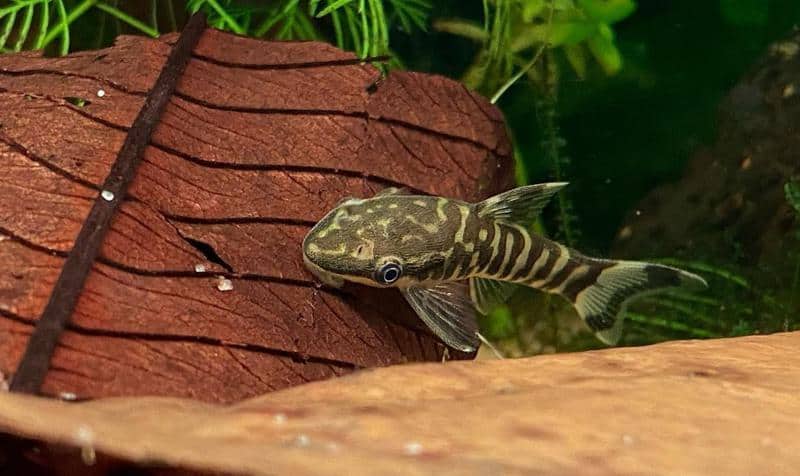
Minimum Tank Size
You can keep Otos in small tanks, as small as 10 gallons. However, the 10-gallon tank is the minimum for a group of 6 Otocinclus catfish. For bigger groups, a 20-gallon tank is the minimum tank size.
Otos need plenty of swimming space and a stable environment to thrive; the bigger the tank, the better and easier it would be to maintain an optimal environment.
Ecosystem
The ecosystem is all about what to include inside their tank; that includes ideal compatible tank mates to the design and layout of the entire tank.
Since the Otocinclus catfish are native to South America, they prefer a well-planted aquarium with plenty of hiding places. They also require a smooth substrate, such as sand or smooth gravel, as their undersides are delicate and can be easily injured.
Smooth substrate helps avoid scratches that can be inflicted on small fish quite easily. Scratches cause infections and, in turn, diseases which may eventually lead to an outbreak.
Otos love decorative ornaments like caves and big rocks, which give them a lot of space to hideout and rest. Plants and driftwood will help provide a natural source of food as well as a playground for cute little pets.
If you are wondering how many Otocinclus Catfish should be kept together, then you already know that they are schooling fish that thrive when placed in large groups. A group of 3 – 10 is the most common, but some aquarists prefer groups of 20. Your preference will boil down to the size of your tank and the capabilities of your aquarium.
Lighting for the Otos does not need to be fancy or high-end; these species thrive on standard aquarium lights provided they are able to get 12 hours of darkness and mid-level light exposure during the day.
Filtration systems, on the other hand, need to be top-notch since Otocinclus Catfish are highly sensitive to bad water conditions. Fluctuations in pH, ammonia, nitrate, and other impurities can easily kill a whole group of Otos in a matter of days. Also, add a water heater to keep the fish warm and temperatures optimal.
Otos live in well-oxygenated waters in the wild. Adding a bubbler, albeit not essential, can also help provide an oxygen-rich environment for the fish to thrive in.
Otocinclus Water Parameters & Water Conditions
Otos require clean water with low levels of nitrates and ammonia. A good filtration system and regular water changes (20 – 30 percent bi-weekly changes) are essential for maintaining their water conditions.
Have the filtration system cycle your water about four times in one hour and stock plants that also help keep the ecosystem pristine.
Recommended parameters:
- pH Levels: 5 – 8.0
- Water Temperature: 70 – 80 degrees Fahrenheit
- Water hardness: 4 – 2- dGH
- Ammonia, nitrite levels: 0 PPM
What Do Otocinclus Eat: Food & Diet
Otocinclus catfish are primarily herbivores that prefer a diet rich in softer algae, aufwuchs, and plant matter. They will also eat sinking pellets and flakes, but these nutrients should not make up their natural diet. Adding live plants to the aquarium can provide a natural source of food for them.
Most of the Otos you find in pet stores are wild-caught and not raised in captivity. Beginners are sometimes discouraged from owning Otocinclus fish under the assumption that they are hard to keep in captivity due to dietary restrictions.
The challenge of breeding Otocinclus catfish is that they need a high-protein diet to mate properly and reproduce. Such a diet is readily available in the wild but can take a lot of trial & error for a hobbyist to nail down their favorite food.
If you do not provide the Otos with protein-filled content like algae wafers, brine shrimp, and daphnia, then they may not easily reproduce, let alone thrive in the tank.
A good place to try if you are confused about the food is to get commercial pet store food specifically made for fish that eat aufwuchs (the small plants and life matter that cover aquarium substrates & surfaces).
The dwarf suckers also love vegetable-based foods like zucchini, canned green beans, and spinach. Try leaving the veggies in the tank for about 24 hours to ensure they are soft and mushy; this makes it much easier for the Otos to eat.
TIP: Buy Otos that already have good eating habits in a captivity environment. These are fish from mature cycled tanks that have been fed their favorite foods for some time. These types of Otos are more adaptable and will survive much better once you start feeding them in your own tank.
Ideal Tank Mates
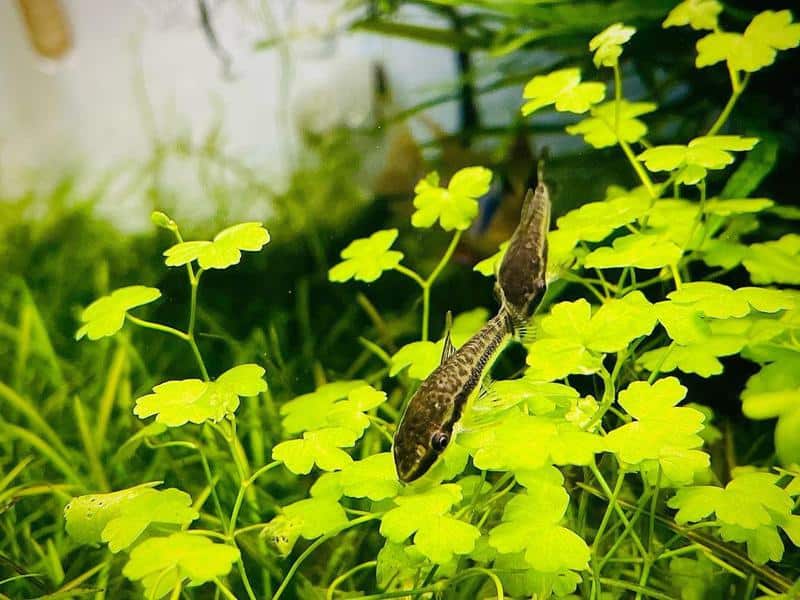
Otocinclus catfish are peaceful and can coexist with a wide range of community fish, such as tetras, guppies, and Corydoras.
However, they should not be kept with larger, aggressive fish that may harm them. That means you should avoid the likes of Cichlids, Oscars, Goldfish, and Jack Dempsey.
Another caution is to avoid keeping fish with large mouths, large enough to swallow the Otos in one swoop.
Some fishes, like the bettas, may not be aggressive but can be quite territorial. In this case, you may want to ensure that territorial fish are kept in small numbers and have enough spaces to call their home and not feel threatened by other fishes. This helps reduce the chances that they may inconvenience your Otos.
Since the Otos are also algae eaters, you do not want them to be competing for food with other algae-eating fish that may get aggressive.
Feel free to add invertebrates like snails and shrimps in a tank populated by Otos.
Ideal tank mates you may want to start with include the following:
- Neon Tetra
- Black skirt tetras
- Guppies
- Endlers livebearers
- Betta fish
- Platies
- Zebra danio
- Denison Barb
- Clown Plecos
- Mollies
- Dwarf Gouramis
- Cherry barb
- Harlequin Rasbora
- Corydoras catfish
- Snails like the mystery & nerite snails
- Shrimps like the Amano & ghost shrimp
Otocinclus Catfish Breeding
As previously stated, diet is the most important thing when it comes to breeding Otos. Keep the high-protein diet upon the fish’s sexual maturity, which is about 6 – 9 months of age.
Breeding Otocinclus catfish in captivity can be challenging, but it is possible with the right conditions. They require a mature, well-planted aquarium with plenty of hiding places and a good supply of food.
The breeding process usually involves the female laying eggs on a surface, which are then fertilized by the male. The eggs will hatch in 2 -3 days, and the fry will require a separate rearing tank until they are large enough to join the community tank.
Increase the temperature to the high 70s to boost the chances of mating. A perfectly clean and healthy aquarium will boost the breeding even further. If you have difficulty getting the fish to mate, then consulting a professional breeder is the best option.
Common Diseases That Affect Oto Fish
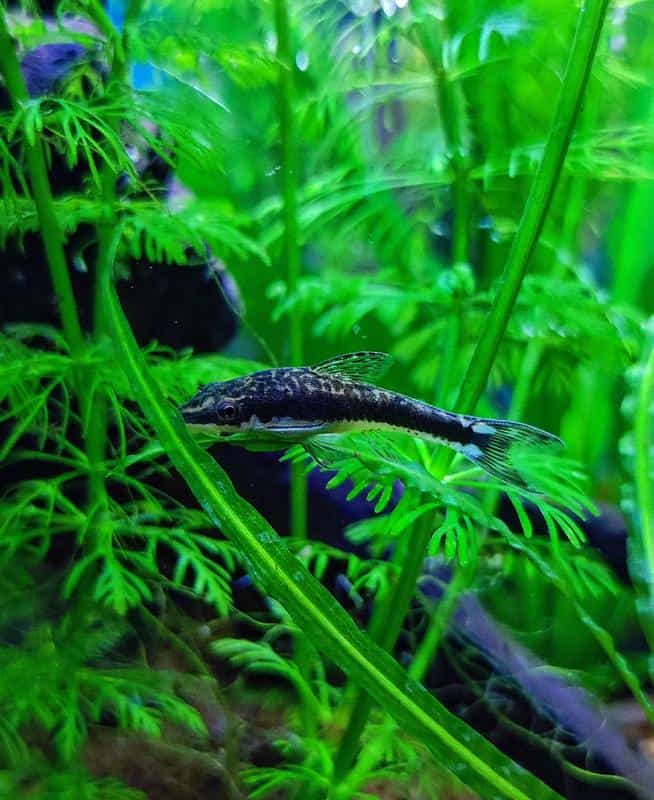
Otos, like any other fish, are susceptible to various diseases that parasites, bacteria, or viruses can cause.
Knowing the signs and symptoms of these diseases can help you identify them early and take the necessary steps to treat them. Some common fish diseases that can affect Otocinclus catfish include:
1. Ich (White Spot Disease)
Ich, also known as white spot disease, is a common fish disease caused by the parasite Ichthyophthirius multifiliis. It is characterized by small white spots on the fish’s body, fins, and gills.
Use commercial medications available in pet stores to treat ich. Raising the temperature of the aquarium above 80 degrees Fahrenheit for a few days will also help since it speeds up the life cycle of the parasite. Take note that higher temperatures can also stress fish and should not be done for long.
2. Fin Rot
Fin rot is a bacterial infection that can affect the fins and tail of the fish. It is caused by poor water quality or injury. Symptoms include disintegrating fins and tail, as well as redness or inflammation around the affected area.
Use bacterial medication available in pet stores to treat fin rot.
3. Dropsy
Dropsy is a bacterial infection that affects the fish’s internal organs, causing fluid buildup in the body. Often characterized by a swollen belly, bulging eyes, and raised scales.
Unfortunately, dropsy is difficult to treat and is often fatal. The best course of action is to isolate the affected fish and euthanize it to prevent the spread of the disease to other fish in the aquarium.
All in all, ensure you monitor your fish for any signs of illness and act as soon as possible to prevent the spread of the disease to other fish in the aquarium. If the infection is severe, you may need to remove the affected fish and quarantine it in a separate tank for treatment.
Also Read:
FAQs
Why Is My Otocinclus Swimming Up And Down?
Do not be alarmed if you notice your Oto swimming up and down. Most likely, it is because the Oto, like other air-breathing fish, wants to get a big gulp of air from the top surfaces of the tank.
This will happen a few times, but if it is becoming more frequent, then you may want to see if the water conditions are affected. It can be a sign of sickness or stress if the frequency gets higher and higher.
Otocinclus Catfish Price
It is easy to find Otocinclus catfish for sale in many pet stores, both online and locally. Prices are very affordable, and you will often snag small one-inch Otos for just $3 – $9.
Conclusion
Otocinclus catfish are a great addition to any community aquarium. They are great algae eaters, peaceful, and easy to care for. By following the guidelines outlined in this guide, you have ensured that your Otocinclus catfish thrives and lives a long healthy life in your aquarium.
